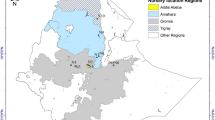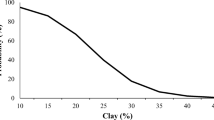Abstract
Conifer seedlings grown in bare-root nurseries are frequently damaged and destroyed by soil-borne pathogenic fungi that cause root rot. Relationships between nursery cultural practices, soil characteristics, and populations of potential pathogens in the soil were examined in three bare-root tree nurseries in the Midwestern USA. Soil-borne populations of Fusarium spp. and Pythium spp. were enumerated as a function of soil depth in the upper 42 cm; red and white pine seedling root systems were assessed visually for signs of root rot. Soil organic carbon and resistance to cone penetration (as a function of depth) were augmented by saturated hydraulic conductivity (Ksat), water retention characteristic, texture and pH at selected depths. Cone index (CI) provided accurate ‘fingerprints’ of cultural practices in each nursery. A tillage pan due to rotary tillage was detected by CI in the Minnesota and Wisconsin nurseries, but no such tillage pan was indicated in the Michigan nursery, which did not use rotary tillage. Curves of CI also indicated differing maximum depth of tillage disturbance between nurseries; maximum rooting depth based on 3 MPa CI were different among nurseries. Vertical distribution of soil-borne Fusarium spp. reflected the vertical incorporation pattern associated with the type of tillage implement used to incorporate cover crop residue prior to Pinus seedling establishment. Peak numbers of Fusarium spp., from 250 to 950 colony-forming units (cfu g-1 dry soil) were recorded between 12 – 24 cm depth in two nurseries using a moldboard plow for incorporation while steadily decreasing populations, from 1800 to 250 cfu g-1 dry soil, were found from 0 to 15 cm in the third nursery using a disc. Vertical distribution of the Fusarium spp. also correlated with organic carbon levels, which suggested that cover-crop incorporation and conifer rooting had determined the location of soil-borne Fusarium spp. propagules. Ksat suggest that tillage pans caused by rotary tillage may impede drainage during nearly daily irrigation enough to cause physiological stress to the seedlings and predispose them to disease. Low levels of mortality (from < 1% to 5%) were observed in two-year-old Pinus seedlings while disease severity varied by nursery and seedling species. Tillage should be used to control depth placement of biomass residue and pathogenic fungal propagules, and adjusted to prevent tillage pans within the seedling root zone. More studies are needed to determine the impact of these cultural controls on the need and application depth of fumigation for pathogen control.
Similar content being viewed by others
References
Allmaras R R, Copeland S M, Copeland P J and Oussible M 1996 Spatial relations between oat residue and ceramic spheres when incorporated sequentially by tillage. Soil Sci. Soc. Am. J. 60, 1209-1216.
Allmaras R R, Juzwik J, Overton R P and Copeland S M 1994 Soil compaction: Causes, effects, management in bare-root nurseries. In Proc. Northeastern and Intermountain Forest and Conservation Nursery Association. Tech. Coord. T. Landis. pp 19-32. USDA For. Serv. Gen. Tech. Rep. RM-243.
Allmaras R R and Logsden S M 1990 Soil structural influences on the root zone and rhizosphere. In Rhizosphere Dynamics. pp 8-54. AAAS, Washington, DC.
Allmaras R R, Kraft J M and Miller D E 1988a Effects of soil compaction and incorporated crop residue on root health. Ann. Rev. Phytopathol. 26, 219-243.
Allmaras R R, Pikul J L Jr, Kraft J M and Wilkins D E 1988b A method for measuring incorporated crop residue and associated soil properties. Soil Sci. Soc. Am. J. 52, 1128-1133.
Allmaras R R, Kraft J M and Pikul J L Jr 1987 Lime and gypsum effects on pea-root-pathogen inoculum and related factors in a wheat-pea rotation. Agron. J. 79, 439-445.
Anderson N A, French D W and Taylor D P 1962 Cylindrocladium root rot of conifers in Minnesota. For. Sci. 8, 378-382.
Asady G H, Smucker A J M and Adams W 1985 Seedling test for quantitative measurement of root tolerances to compacted soil. Crop Sci. 25, 802-806.
Bloomberg, W J 1985 The epidemiology of forest nursery diseases. Ann. Rev. Phytopathol. 23,83-96.
Boone F R, vanderWerf H M G, Kroesbergen B, ten Hag B A and Boers A 1986 The effect of compaction of the arable layer in sandy soil on the growth of maize for silage. I. Critical matric water potentials in relation to soil aeration and mechanical impedance. Neth J. Agric. Res. 34, 155-171.
Dhingra O D and Sinclair J B 1985 Basic Plant Pathology Methods. CRC Press, Boca Raton, FL. 355 p.
Duryea M L and Landis T D (Eds.) 1984 Forest Nursery Manual: Production of Bareroot Seedlings. Martinus Nijhoff/Dr. W. Junk Publishers. The Hague, The Netherlands 385 p.
Graecen E L, and Sands R 1980 Compaction of forest soils. A review. Aust. J. Soil Res. 18, 63-189.
Gust K M 1996 Conifer root pathogen populations in relation to soil characteristics and cultural practices in three bareroot forest tree nurseries. MSc Thesis, Univ. of Minn., St. Paul, USA. 67 p.
Hamblin A P 1985 The influence of soil structure on water movement, crop root growth, and water uptake. Adv. Agron. 38, 95-158.
Horton R, Ankeny M D and Allmaras R R 1994 Effects of compaction on soil hydraulic properties. In Soil Compaction in Crop Production. Eds. B D Soane and C van Ouwerkerk. pp 141-165. Elsevier, Amsterdam, The Netherlands.
Jeffers S N and Martin S B 1986 Comparison of two media selective for Phytophthora and Pythium spp. Plant Dis. 70, 1038-1043.
Juzwik J and Rugg D J 1996 Seedling mortality and development of root rot in white pine seedlings in two bare-root nurseries. Can. J. Plant Path. 18, 335-341.
Juzwik J, Menes P J and Rugg, D J 1994 Soil moisture and Fusarium root rot of white pine seedlings. In Proc. Northeastern and Intermountaion Forest and Conservation Nursery Association. Tech. Coord. T. Landis. pp. 85-90.
Juzwik J, Stenlund D L, Allmaras R R, Copeland S M and McRoberts R E 1997 Incorporation of tracers and dazomet by rotary tillers and a spading machine. Soil and Tillage Res. 41, 237-248. USDA For. Serv. Gen. Tech. Rep. RM-243.
Klute A 1986 Water retention: Laboratory methods. In Methods of Soil Analysis Part 1. 2nd ed. Ed. A Klute. pp 635-662. Agron. Monogr. 9. Am. Soc. Agron. Madison, WI.
Klute A and Dirksen C 1986 Hydraulic conductivity and diffusivity: Laboratory methods. In Methods of Soil Analysis Part 1 Second Edition. Ed. A Klute. pp 687-734. Agron. Monogr. 9. Am. Soc. Agron., Madison, WI.
Laboski C A M, Dowdy R H, Allmaras R R and Lamb J A 1998 Soil strength and water content influences on corn root distribution in a sandy soil. Plant and Soil. 203, 239-247.
Larson W E, Eynard A, Hadas A and Lipiec, J 1994 Chap. 25. Control and avoidance of soil compaction in practice. In Soil Compaction in Crop Production, Eds. B D Soane and C van Ouwerkerk. pp 597-625. Elsevier Science, Amsterdam, The Netherlands.
Misra R K, and Gibbons, A K 1996 Growth and morphology of eucalypt seedling-roots, in relation to soil strength arising from compaction. Plant Soil 182, 1-11.
Nelson P E, Tousson T A and Marasas W F O 1983 Fusarium Species: An Illustrated Guide for Identification. The Pennsylvania State Univ. Press, University Park, PA. 193 p.
Ocamb C M and Juzwik J 1993 Seed-borne Fusarium species in untreated eastern white pine seed. Phytopathology 83, 1411.
Ocamb C M and Juzwik J 1995 Fusarium species associated with rhizosphere soil and diseased roots of eastern white pine nursery seedlings and associated nursery soil. Can. J. Plant Path. 17, 325-330.
Papavizas G C 1967 Evaluation of various media and anti microbial agents for isolation of Fusarium from soil. Phytopathology 57, 848-852.
Paul E A and Clark F E 1996 Soil Microbiology and Biochemistry. 2nd ed. Academic Press, New York. 340 p.
Riffle J W and Strong F C 1960 Studies in white pine seedling root rot. Quarterly Bull. Mich. Agric. Expt. Sta. 42, 845-853.
Rothrock C S 1992 Tillage systems and plant disease. Soil Sci. 154, 308-315.
Staricka J A, Allmaras R R and Nelson W W 1991 Spatial variation of crop residue incorporated by tillage. Soil Sci. Soc. Am. J. 55, 1668-1674.
Steel R G D and Torrie J H 1980 Principles and Procedures of Statistics. Mc Graw-Hill Book Co. Toronto, Canada. 633 p.
Stepniewski W, Glinski J and Ball D C 1994 Effects of compaction on soil aeration properties. In Soil Compaction in Crop Production Eds. B D Soane and C van Ouwerkerk. pp 167-189. Elsevier, Amsterdam, The Netherlands.
Sutherland J R and Anderson R L 1980 Seedling disease and insect problems related to nursery soil conditions in North America. In North America Forest Tree Nursery Soils Workshop Eds. L P Abrahamson and D H Bickelhaupt. pp 182-190. New York State University, Syracuse, NY.
Thies W G and Patton R F 1971 Evaluation of cylindrocladium root rot control by fumigation. For. Sci. 17, 323-331.
USDA, NAPIAP 1993 The Biologic and Economic Assessment of Methyl Bromide. United States Department of Agriculture, Washington D C USA. 99 p.
Vaartaja O 1964 Survival of Fusarium, Pythium, and Rhizoctonia in very dry soil. Can. Dept. Agric. Sci. Serv. Bimon. Prog. Rep. 20, 3.
Voorhees W B, Farrell D A and Larson W E 1975 Soil strength and aeration effects on root elongation. Soil Sci. Soc. Am. Proc. 39, 948-953.
Wilkinson L 1992 SYSTAT for Windows: Statistics. Version 5.0 SYSTAT, Inc. Evanston IL. 750 p.
Williams L E and Schmitthenner A F 1960 Effect of growing crops and crop residues on soil fungi and seedling blights. Phytopathology 50, 22-25.
Author information
Authors and Affiliations
Rights and permissions
About this article
Cite this article
Juzwik, J., Gust, K. & Allmaras, R. Influence of cultural practices on edaphic factors related to root disease in Pinus nursery seedlings. Plant Soil 207, 195–208 (1999). https://doi.org/10.1023/A:1026441014147
Issue Date:
DOI: https://doi.org/10.1023/A:1026441014147




